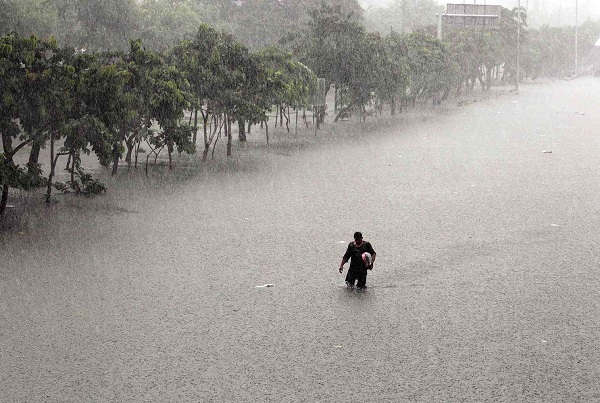Leptospirosis risk increases after heavy rain, flooding

A MAN waded through a flooded section of Osmeña Highway in Makati City, the country’s financial district. AP FILE PHOTO
In humans, leptospirosis—bacterial infection acquired mainly by wading in water contaminated by infected rats’ urine—can cause a wide range of symptoms that include high fever, headache, muscle aches, vomiting, jaundice (yellowing of skin and eyes), reddening of the eyes, abdominal pain, diarrhea and even rash.
Because of these nonspecific and confusing symptoms as well as the fact that these symptoms appear more than a week after exposure, patients sometimes end up being diagnosed with another similar condition like flu, dengue or sometimes food poisoning.
One should remember that leptospirosis—caused by a strain of bacteria called Leptospira—could only be confirmed by undergoing a specific antibody test available through public health laboratories and by culture. Taking this test is essential because antibiotic treatment is most effective when initiated early in the course of the disease.
If not treated properly, the patient could develop serious complications like kidney damage, meningitis (inflammation of the protective membranes covering the brain and spinal cord), liver failure and respiratory distress. Death may occur in a number of cases.
62% higher
Data from the Department of Health’s National Epidemiology Center showed that the number of leptospirosis cases from January to August alone has reached 2,471. This is 62 percent higher than the 1,522 leptospirosis patients confined in government hospitals during the same period last year. Interestingly this figure is set to get worse as 631 cases and 249 hospital admissions were reported last week in Olongapo City alone.
Treatment options for these patients with signs or symptoms of leptospirosis include oral doxycycline, ampicillin and amoxicillin for mild cases. Moderate or severe cases will require intravenous antimicrobial therapy with penicillin, ceftriaxone, or ampicillin. For moderately- or severely-ill patients with compatible illness, early antibiotic treatment is usually strongly considered regardless of testing results.
Best protection
While not wading in potentially contaminated flood waters is the best protection against leptospirosis, wearing protective clothing or footwear may also help from getting scraped or wounded, which are the usual points of infection.
Even without a wound, leptospirosis can penetrate the body through the mucous membranes of the eyes, nose and mouth. Walking in muddy areas, farmlands and garbage-infested places is also risky.
Human-to-human transmission is rare.
